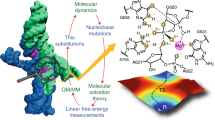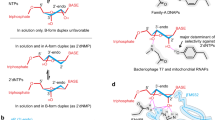Abstract
Recent crystallographic and functional analyses of RNA enzymes have raised the possibility that the purine and pyrimidine nucleobases may function as general acid-base catalysts. However, this mode of nucleobase-mediated catalysis has been difficult to establish unambiguously. Here, we used a hyperactivated RNA substrate bearing a 5′-phosphorothiolate to investigate the role of a critical cytosine residue in the hepatitis delta virus ribozyme. The hyperactivated substrate specifically suppressed the deleterious effects of cytosine mutations and pH changes, thereby linking the protonation of the nucleobase to leaving-group stabilization. We conclude that the active-site cytosine provides general acid catalysis, mediating proton transfer to the leaving group through a protonated N3-imino nitrogen. These results establish a specific role for a nucleobase in a ribozyme reaction and support the proposal that RNA nucleobases may function in a manner analogous to that of catalytic histidine residues in protein enzymes.
This is a preview of subscription content, access via your institution
Access options
Subscribe to this journal
Receive 12 print issues and online access
$259.00 per year
only $21.58 per issue
Buy this article
- Purchase on Springer Link
- Instant access to full article PDF
Prices may be subject to local taxes which are calculated during checkout






Similar content being viewed by others
References
Ferre-D'Amare, A.R., Zhou, K. & Doudna, J.A. Crystal structure of a hepatitis delta virus ribozyme. Nature 395, 567–574 (1998).
Murray, J.B., Seyhan, A.A., Walter, N.G., Burke, J.M. & Scott, W.G. The hammerhead, hairpin and VS ribozymes are catalytically proficient in monovalent cations alone. Chem. Biol. 5, 587–595 (1998).
Perrotta, A.T., Shih, I. & Been, M.D. Imidazole rescue of a cytosine mutation in a self-cleaving ribozyme. Science 286, 123–126 (1999).
Shih, I.H. & Been, M.D. Involvement of a cytosine side chain in proton transfer in the rate-determining step of ribozyme self-cleavage. Proc. Natl. Acad. Sci. USA 98, 1489–1494 (2001).
Nakano, S., Chadalavada, D.M. & Bevilacqua, P.C. General acid-base catalysis in the mechanism of a hepatitis delta virus ribozyme. Science 287, 1493–1497 (2000).
Pinard, R. et al. Functional involvement of G8 in the hairpin ribozyme cleavage mechanism. EMBO J. 20, 6434–6442 (2001).
Lebruska, L.L., Kuzmine, I.I. & Fedor, M.J. Rescue of an abasic hairpin ribozyme by cationic nucleobases: evidence for a novel mechanism of RNA catalysis. Chem. Biol. 9, 465–473 (2002).
Rupert, P.B., Massey, A.P., Sigurdsson, S.T. & Ferre-D'Amare, A.R. Transition state stabilization by a catalytic RNA. Science 298, 1421–1424 (2002).
Ban, N., Nissen, P., Hansen, J., Moore, P.B. & Steitz, T.A. The complete atomic structure of the large ribosomal subunit at 2.4 Å resolution. Science 289, 905–920 (2000).
Youngman, E.M., Brunelle, J.L., Kochaniak, A.B. & Green, R. The active site of the ribosome is composed of two layers of conserved nucleotides with distinct roles in peptide bond formation and peptide release. Cell 117, 589–599 (2004).
Shih, I.H. & Been, M.D. Catalytic strategies of the hepatitis delta virus ribozymes. Annu. Rev. Biochem. 71, 887–917 (2002).
Nakano, S. & Bevilacqua, P.C. Proton inventory of the genomic HDV ribozyme in Mg2+-containing solutions. J. Am. Chem. Soc. 123, 11333–11334 (2001).
Oyelere, A.K., Kardon, J.R. & Strobel, S.A. pK a perturbation in genomic hepatitis delta virus ribozyme catalysis evidenced by nucleotide analogue interference mapping. Biochemistry 41, 3667–3675 (2002).
Ke, A., Zhou, K., Ding, F., Cate, J.H. & Doudna, J.A. A conformational switch controls hepatitis delta virus ribozyme catalysis. Nature 429, 201–205 (2004).
Pereira, M.J., Harris, D.A., Rueda, D. & Walter, N.G. Reaction pathway of the trans-acting hepatitis delta virus ribozyme: a conformational change accompanies catalysis. Biochemistry 41, 730–740 (2002).
Harris, D.A., Rueda, D. & Walter, N.G. Local conformational changes in the catalytic core of the trans-acting hepatitis delta virus ribozyme accompany catalysis. Biochemistry 41, 12051–12061 (2002).
Ouellet, J. & Perreault, J.P. Cross-linking experiments reveal the presence of novel structural features between a hepatitis delta virus ribozyme and its substrate. RNA 10, 1059–1072 (2004).
Bevilacqua, P.C. Mechanistic considerations for general acid-base catalysis by RNA: Revisiting the mechanism of the hairpin ribozyme. Biochemistry 42, 2259–2265 (2003).
Thompson, J.E. & Raines, R.T. Value of general acid-base catalysis to ribonuclease-A. J. Am. Chem. Soc. 116, 5467–5468 (1994).
MacLeod, A.M., Tull, D., Rupitz, K., Warren, R.A. & Withers, S.G. Mechanistic consequences of mutation of active site carboxylates in a retaining β-1,4-glycanase from Cellulomonas fimi . Biochemistry 35, 13165–13172 (1996).
Hoff, R.H., Hengge, A.C., Wu, L., Keng, Y.F. & Zhang, Z.Y. Effects on general acid catalysis from mutations of the invariant tryptophan and arginine residues in the protein tyrosine phosphatase from Yersinia . Biochemistry 39, 46–54 (2000).
Yoshida, A., Shan, S., Herschlag, D. & Piccirilli, J.A. The role of the cleavage site 2′-hydroxyl in the Tetrahymena group I ribozyme reaction. Chem. Biol. 7, 85–96 (2000).
Zhao, L., Liu, Y., Bruzik, K.S. & Tsai, M.D. A novel calcium-dependent bacterial phosphatidylinositol-specific phospholipase C displaying unprecedented magnitudes of thio effect, inverse thio effect, and stereoselectivity. J. Am. Chem. Soc. 125, 22–23 (2003).
Krogh, B.O. & Shuman, S. Catalytic mechanism of DNA topoisomerase IB. Mol. Cell 5, 1035–1041 (2000).
Kuimelis, R.G. & McLaughlin, L.W. Application of a 5′-bridging phosphorothioate to probe divalent metal and hammerhead ribozyme mediated RNA cleavage. Bioorg. Med. Chem. 5, 1051–1061 (1997).
Zhou, D.M., Zhang, L.H. & Taira, K. Explanation by the double-metal-ion mechanism of catalysis for the differential metal ion effects on the cleavage rates of 5′-oxy and 5′-thio substrates by a hammerhead ribozyme. Proc. Natl. Acad. Sci. USA 94, 14343–14348 (1997).
Fife, T.H. & Milstien, S. Carboxyl-group participation in phosphorothioate hydrolysis: hydrolysis of s-(2-carboxyphenyl) phosphorothioate. J. Org. Chem. 34, 4007–4012 (1969).
Chaulk, S.G. & MacMillan, A.M. Caged RNA: photo-control of a ribozyme reaction. Nucleic Acids Res. 26, 3173–3178 (1998).
Shih, I. & Been, M.D. Kinetic scheme for intermolecular RNA cleavage by a ribozyme derived from hepatitis delta virus RNA. Biochemistry 39, 9055–9066 (2000).
Bevilacqua, P.C., Brown, T.S., Nakano, S. & Yajima, R. Catalytic roles for proton transfer and protonation in ribozymes. Biopolymers 73, 90–109 (2004).
Juneau, K., Podell, E., Harrington, D.J. & Cech, T.R. Structural basis of the enhanced stability of a mutant ribozyme domain and a detailed view of RNA-solvent interactions. Structure 9, 221–231 (2001).
Searls, T. & McLaughlin, L.W. Synthesis of the analogue nucleoside 3-deaza-2′-deoxycytidine and its template activity with DNA polymerase. Tetrahedron 55, 11985–11996 (1999).
Cook, P.D., Day, R.T. & Robins, R.K. Improved synthesis of 3-deazacytosine, 3-deazauracil, 3-deazacytidine, and 3-deazauridine. J. Heterocyclic Chem. 14, 1295–1298 (1977).
Bevers, S. & Mclaughlin, L.W. Use of analogue nucleosides to probe function in the hammerhead ribozyme. in Ribozyme: Biochemistry and Biotechnology (eds. Krupp, G. & Gaur, R.K.) 171–190 (Eaton Publishing, Natick, Massachusetts, 2000).
Moore, M.J. & Sharp, P.A. Site-specific modification of pre-mRNA: the 2′-hydroxyl groups at the splice sites. Science 256, 992–997 (1992).
Moore, M.J. & Query, C.C. Joining of RNAs by splinted ligation. Methods Enzymol. 317, 109–123 (2000).
Nakano, S., Proctor, D.J. & Bevilacqua, P.C. Mechanistic characterization of the HDV genomic ribozyme: assessing the catalytic and structural contributions of divalent metal ions within a multichannel reaction mechanism. Biochemistry 40, 12022–12038 (2001).
Romanova, D. & Novotny, L. Chromatographic properties of cytosine, cytidine and their synthetic analogues. J. Chromatog. B. 675, 9–15 (1996).
Beigelman, L., Karpeisky, A. & Usman, N. Synthesis of 6-aza-pyrimidine and 6-methyl-pyrimidine ribonucleoside phosphoramidites and their incorporation in hammerhead ribozymes. Nucleosides Nucleotides 14, 895–899 (1995).
Hiley, S.L., Sood, V.D., Fan, J. & Collins, R.A. 4-thio-U cross-linking identifies the active site of the VS ribozyme. EMBO J. 21, 4691–4698 (2002).
Lilley, D.M.J. The Varkud satellite ribozyme. RNA 10, 151–158 (2004).
Winkler, W.C., Nahvi, A., Roth, A., Collins, J.A. & Breaker, R.R. Control of gene expression by a natural metabolite-responsive ribozyme. Nature 428, 281–286 (2004).
Milligan, J.F. & Uhlenbeck, O.C. Synthesis of small RNAs using T7 RNA polymerase. Methods Enzymol. 180, 51–62 (1989).
Kao, C., Zheng, M. & Rudisser, S. A simple and efficient method to reduce nontemplated nucleotide addition at the 3′ terminus of RNAs transcribed by T7 RNA polymerase. RNA 5, 1268–1272 (1999).
Acknowledgements
We thank A. Ke and J.A. Doudna for helpful discussions and J. Staley, M.D. Been, P.C. Bevilacqua, D. Herschlag and members of the Piccirilli laboratory for critical comments and suggestions on the manuscript. We also thank J. Olvera for T4 DNA ligase and E. Duguid for assistance with MALDI mass spectroscopy. This work was supported by the Howard Hughes Medical Institute.
Author information
Authors and Affiliations
Corresponding author
Ethics declarations
Competing interests
The authors declare no competing financial interests.
Supplementary information
Supplementary Fig. 1
1H-NMR spectrum of 2′-O-TBDMS-5′-O-DMTr-N4-phenoxyacetyl-3-deazacytidine which was phosphitylated to obtain the phosphoramidite analogue (31P-NMR peaks at δ 150.4 ppm and 149.8 ppm; H3PO4 external standard) for solid phase synthesis. (PDF 5340 kb)
Supplementary Fig. 2
1H-NMR spectrum of 2′-OTBDMS-5′-O-DMTr-N4-acetyl-6-azacytidine which was phosphitylated to obtain the phosphoramidite analogue (31P-NMR peaks at δ 150.6 ppm and 149.6 ppm; H3PO4 external standard) for solid phase synthesis. (PDF 5527 kb)
Rights and permissions
About this article
Cite this article
Das, S., Piccirilli, J. General acid catalysis by the hepatitis delta virus ribozyme. Nat Chem Biol 1, 45–52 (2005). https://doi.org/10.1038/nchembio703
Received:
Accepted:
Published:
Issue Date:
DOI: https://doi.org/10.1038/nchembio703
This article is cited by
-
Structural basis for substrate binding and catalysis by a self-alkylating ribozyme
Nature Chemical Biology (2022)
-
A Cofactor-Based Mechanism for the Origin of the Genetic Code
Origins of Life and Evolution of Biospheres (2022)
-
Zn2+-dependent DNAzymes that cleave all combinations of ribonucleotides
Communications Biology (2021)
-
Topological constraints of structural elements in regulation of catalytic activity in HDV-like self-cleaving ribozymes
Scientific Reports (2016)
-
Ribozymes and the mechanisms that underlie RNA catalysis
Frontiers of Chemical Science and Engineering (2016)



